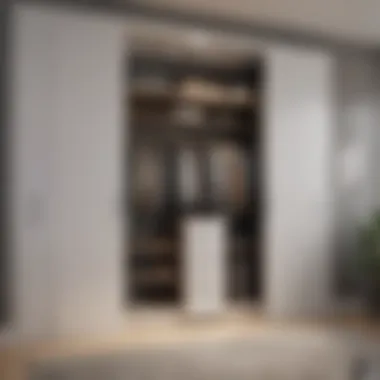Maximizing Your Extra Closet Space: Smart Strategies


Intro
Effective use of closet space can greatly enhance the functionality and aesthetics of your home. Often, homeowners overlook the potential of their extra closet space, allowing it to remain as a mere storage area filled with clutter. This article aims to provide insightful strategies to transform these underused areas into organized, practical solutions. By incorporating specific techniques and ideas, you can optimize every corner of your closets, making them serve not just a purpose but also enhance your daily life. In this exploration, we will uncover details, methods, and recommendations that put your extra closet space to work for you.
Featured Homes
Architectural Highlights
When discussing closet optimization, it is essential to consider the architectural context. Different home designs present unique opportunities and challenges. For instance, a Victorian-style home may have high ceilings, allowing for vertical storage solutions. Meanwhile, a modern apartment may showcase built-in cabinets or open shelving that can be used creatively. Maximizing these variations can lead to innovative storage solutions tailored to your living space.
Interior Design Themes
Closets can also reflect a specific interior design theme. If your home follows a minimalistic design, using clear storage containers can keep the space looking tidy. On the other hand, a bohemian style may benefit from soft fabric storage solutions that add texture while organizing items. The choice of design elements, colors, and materials can influence how effectively a closet serves you.
Strategies for Efficient Use of Closet Space
To make the most of extra closet space, consider the following strategies:
- Maximize Vertical Space: Use shelves that extend to the ceiling for storage. This method helps keep items off the floor and utilizes all available height.
- Incorporate Multi-Functional Furniture: Benches or ottomans with storage compartments can add seating while providing room for extra items.
- Use Clear Containers: These allow you to see contents at a glance, reducing the time spent searching for items.
- Labeled Bins: Organized bins, labeled for easy identification, can further enhance usability.
- Rotate Seasonal Items: Store off-season clothes in vacuum-sealed bags to manage space effectively throughout the year.
"A cluttered closet can lead to a cluttered mind; organizing your items can improve not just your room's appearance, but your overall well-being."
These strategies present various ways to adapt and organize closet spaces to fit your lifestyle and preferences, enhancing the efficiency of your living environment.
End
Understanding the Value of Extra Closet Space
Extra closet space represents an often-overlooked opportunity for enhancing the functionality of your home. With the continual demand for minimalism and organization in urban and suburban living, optimizing this underutilized area can provide significant benefits. Effective use of extra closet space can greatly enhance orderliness and improve overall quality of life by decluttering other areas in the home.
One of the most immediate benefits of understanding the value of extra closet space is the creation of more efficient living surroundings. When closets function well, they serve as a centralized location for various items, thus preventing clutter from spreading throughout the living areas. Furthermore, this can lead to less stress, as having a designated space for belongings simplifies finding and using them. A well-organized closet can also protect valuable items from damage or disarray, extending their longevity.
Defining Extra Closet Space
Extra closet space is typically defined as any additional storage area that is not being fully utilized to its potential. This can be found in various forms, such as spare coat closets, linen closets, or even deep storage compartments that go unnoticed. These spaces can also exist in unconventional areas like under-stair nooks or hallway cabinets. Understanding what constitutes extra closet space helps individuals identify where improvements can be made.
When people look at their closets, many see only clothes or supplies. However, the term encompasses a broader aspect of potential storage solutions. Recognizing that extra closet space can also be adapted for various purposes, such as seasonal storage or hobby materials, opens up avenues for maximizing its use.
Assessing Your Storage Needs
To effectively utilize extra closet space, it is crucial first to assess individual storage needs. This process involves evaluating what items require storage and their frequency of use. Begin by conducting a thorough inventory of what is currently stored in the closet. Consider factors such as:
- Frequency of Use: Identify items used daily, weekly, or seasonally.
- Item Size and Weight: Take note of larger items that may need dedicated space.
- Item Categories: Gather similar items together for a cohesive storage plan.
By understanding the specific requirements of the space, individuals can allocate zones within the closet tailored to their needs. This step is essential in creating an organizational system that remains functional over time. As storage demands evolve, it is beneficial to regularly revisit this assessment to ensure the closet continues to meet user needs effectively.
Practical Organizational Strategies
Categorizing Your Belongings


Categorizing your belongings is a crucial first step to achieving order in an extra closet space. Begin by assessing all items stored within the closet. It is beneficial to create groups based on usage, such as seasonal, daily, or infrequent items.
- Clothes should be grouped by type - shirts, pants, and coats.
- Accessories like bags or belts can be organized based on frequency of use.
- Miscellaneous items can be divided into specific groups like documents, hobby supplies, or memorabilia.
Once categorized, you can decide how to best store these items. This method not only promotes efficiency but also helps you identify items for donation or disposal. Less clutter leads to a neater, more functional space.
Utilizing Storage Bins and Baskets
Storage bins and baskets play a vital role in optimizing closet space. They are versatile, available in various sizes and materials, and can be used to keep items contained. Choose bins that are stackable to make the most of vertical space.
- Open baskets are great for frequently used items.
- Lidded bins protect contents from dust and allow for longer-term storage.
- Color-coded bins can simplify visual access to contents, streamlining the organization process.
The use of storage bins and baskets also reduces visual clutter, aiding in keeping the space looking tidy. Select bins that fit cohesively with your home's décor, further enhancing the overall look of the closet.
Labeling for Easy Access
Labeling items within your closet is essential for maintaining organization. Clear labels provide immediate visual cues, enabling quick access to necessary items. Consider these labeling tips:
- Use waterproof markers for easy, durable labels.
- Employ labeling machines for a more uniform look.
- Combine labels with colors to further simplify identification.
Place labels on the front of bins or baskets so items can be found without having to search through each container. This benefit is particularly valuable when multiple individuals use shared spaces. Consistency in labeling is key to sustaining organization in the long term.
Implementing Vertical Storage Solutions
When floor space is at a premium, vertical storage solutions can dramatically expand your storage capabilities. There are several methods to utilize vertical space effectively:
- Shelves can hold bins, books, or organizers, ensuring items are elevated for better visibility.
- Over-the-door racks provide areas for shoes, accessories, or cleaning supplies, keeping them off the floor.
- Hanging organizers can be attached to the inside of closet doors for additional storage of small items.
Incorporating these solutions can free up valuable floor space, allowing for a more functional use of the closet. By thinking in three dimensions, you can turn cluttered spaces into organized havens.
Effective use of vertical space can maximize storage solutions and significantly improve access to items in your closet.
By embracing these practical organizational strategies, you can transform your extra closet space into a well-structured and efficient storage solution.
Transforming Closets into Functional Spaces
Transforming closets into functional spaces holds significant relevance in enhancing the usability of your home. Often, closets are viewed simply as storage for clothes or miscellaneous items. However, with creativity and planning, these spaces can become much more. A well-organized closet that serves a specific purpose can streamline daily activities, reduce clutter, and even contribute to well-being by providing serene environments.
When you rethink how to use closet space, you also commit to maximizing every square foot of your home. This is especially important in urban areas where living space is often limited. Repurposing a closet can create more utility without extensive renovations or additions. Through this article section, you will explore practical ideas to transform closets, turning them into spaces that cater to your specific needs.
Creating a Home Office Nook
With more individuals working from home, a closet can easily be converted into a home office nook. To start, assess the dimensions of your closet. Take measurements of the available space and consider the placement of power outlets. Ideally, place a compact desk like the IKEA MICKE in the closet to ensure you have enough work surface. This allows for a dedicated workspace that can be closed off when not in use.
Add shelving above the desk to store office supplies and books, promoting an organized setting. Good lighting is important for a workspace; install task lighting to enhance visibility. Another advantage of this transformation is the privacy it offers in contrast to open workspaces. You can maintain focus and reduce distractions, making it a perfect solution for productivity.
Establishing a Mini Library
Transforming a closet into a mini library can greatly benefit those who love reading. By removing clothing rods and adding shelves, you create space to store your favorite books. Use shelves that adjust in height to accommodate various book sizes, ensuring ample storage for your literature.


Include a comfortable chair or bean bag to create a cozy reading nook. Adding soft lighting and some decorations can make the space more inviting. This functional transformation not only provides a place for reading but also increases home value through improved aesthetic sophistication.
Designing a Craft or Hobby Corner
If you are passionate about crafting or have a hobby, a closet can be a fantastic craft corner. Begin by clearing out any existing clutter. After that, invest in modular storage solutions like The Container Store's Elfa system to customize the shelving to hold craft supplies like papers, glues, and tools efficiently.
Ensure to include a folding table if space allows, giving you a surface to work on. Adding a pegboard on the back of the door offers a way to organize tools and keeps them easily accessible. This designated area helps concentrate creative energy without distracting mess in other home areas.
Converting into a Child's Play Area
For families, converting a closet into a child's play area may prove invaluable. Dedicate the space for toys and games instead of allowing them to overflow into common areas.
Line the closet with colorful bins or baskets, labeling them for organization. This teaches children organization skills while keeping the room tidy. Consider painting the interior of the closet in bright colors or using removable wallpaper to make it more fun. Creating such a dedicated area encourages imaginative play while preserving the home's overall aesthetic.
Incorporating Seasonal Storage Solutions
Seasonal storage solutions are an essential part of maximizing the use of extra closet space. These strategies allow you to neatly stow away items that are not in use throughout the year, enabling you to maintain an organized environment and make room for what you currently need. By implementing effective seasonal storage, you can not only enhance the functionality of your spaces but also increase the lifespan of your items, protecting them from damage.
Storing Seasonal Clothing
Storing seasonal clothing requires careful consideration of fabric and climate impacts. Use breathable garment bags for delicate fabrics such as silk or wool, which can be easily damaged if subjected to moisture or poor air circulation. Vacuum-sealed bags can save space while preventing dust accumulation. Always label the bags, noting the contents inside, so retrieval is simple come the next season.
Ensuring that clothing is clean before storage is vital. Stains can become permanent if left unattended, so laundering them beforehand pays off. Store clothing vertically in your closet or use bins for efficient use of space.
Managing Holiday Decorations
Holiday decorations often take up significant space within closets. To manage these items effectively, categorize decorations by type – for example, separate boxes for Christmas, Halloween, and other festive occasions. Use clear plastic bins to easily identify the contents, or opt for colored bins to represent specific holidays. Heavy decorations should be stored at lower levels to prevent accidents when accessing bins.
Consider creating a master list of all holiday items you own. This way, you can avoid purchasing duplicates in the future. When unpacking after the holidays, take the opportunity to assess each item's condition, ensuring only decor in good shape survives another year.
Organizing Outdoor Gear
Outdoor gear organization is crucial for both accessibility and proper maintenance. Begin by grouping items together by type, such as camping supplies, fishing equipment, and sporting goods. Seasonal considerations are important here as well; items that are used predominantly during summer should be stored separately from winter gear.
Install shelves or hooks inside the closet to maximize vertical space. Use labeled bins or baskets to keep smaller items organized. An inventory of what you have will help you know what to repair or replace before heading out to enjoy nature. Protect gear from moisture and pests by using sealed storage solutions, especially for items like tents or sleeping bags.
Tip: Implement a checklist for gear as you pack and unpack it, helping you to ensure nothing is left behind when going on adventures.
Incorporating seasonal storage solutions is not just about organization; it is about creating a more usable home environment. By thoughtfully relegating items to specific times of the year, you can maintain order while ensuring your belongings remain in excellent condition.
Leveraging Technology for Storage Solutions
In today's fast-paced world, leveraging technology can significantly enhance how we manage and organize extra closet space. Technology provides innovative solutions that make storaging easier and more efficient. By utilizing smart tools and applications, one can convert chaotic storage areas into streamlined and managed spaces.
The relevance of this section lies in understanding how technological advancements can facilitate better organization. Smart devices and software applications not only save physical space but also reduce stress and time spent searching for items. Technology simplifies maintenance and tracking, leading to a more organized living environment.
Smart Closet Organizers
Smart closet organizers exemplify the nexus between technology and practical storage solutions. These devices often utilize sensors and automation to help keep track of what is inside your closet. Some have features that can even remind users when to rotate clothes seasonally or to declutter unused items.


Benefits of smart closet organizers include:
- Real-time Inventory Management: Knowing what you have prevents unnecessary purchases and aids in making immediate decisions based on your wardrobe needs.
- Space Optimization: Many smart organizers are designed to maximize vertical space, allowing more items to fit in a confined area.
- User-friendly Interfaces: Most smart organizers come with dedicated apps, which make it straightforward for anyone to utilize their strongest capacities.
"Innovative closet solutions help users reclaim space without requiring extensive renovations or investments."
Apps for Inventory Management
Apps for inventory management have proliferated, providing users with the ability to easily track their belongings. These applications can catalogue items, suggest organizational structures, and remind users of seasonality or special events.
Some common features found in these apps include:
- Barcode Scanning Options: Allowing users to quickly enter items into their inventory by simply scanning a barcode.
- Image Uploads: Users can take pictures of their items to visually track each belonging, which enhances recognition.
- Cloud Access: Many apps offer cloud integration for remote access to inventory data, making it easy for users to check item availability from anywhere.
Overall, the fusion of technology and closet organization represents a significant advancement in personal management. Engaging with these tools can not only declutter spaces but also promote a well-maintained and easily navigable home environment.
Maintaining and Updating Your Closet Space
Maintaining and updating your closet space is essential for ensuring that this area continues to serve its purpose effectively. As life changes, so do storage needs. Regularly revisiting your closet helps to identify what is essential and what can be removed. This not only keeps the space clutter-free but also makes it easier to locate items when needed. A well-maintained closet improves efficiency and enhances the overall aesthetic of the home.
Regular Assessment of Contents
Regular assessment of closet contents is a proactive approach to managing storage solutions. This involves periodically checking what is in your closet and evaluating if each item still has a place in your life. A good practice is to schedule these assessments at least twice a year, ideally during seasonal changes. During this assessment, consider the following:
- Remove Unwanted Items: Take out clothes or items that you have not used in a year. Donate what’s still in good condition.
- Identify Needs and Gaps: Notice whether you have too many shoes or not enough space for seasonal clothing. This gives invaluable insight into your true storage needs.
- Check for Damages: Look for any items that may be damaged and decide if they should be repaired or discarded.
By evaluating what is present, you can make intentional decisions on what to keep, simplifying the contents of your closet.
Periodical Reorganization Tips
Reorganizing your closet periodically is just as important as assessing its contents. Here are some effective tips to keep in mind:
- Change the Layout: Sometimes simply rearranging the items can create more space. Experiment with different layouts to find what works best.
- Use Uniform Hangers: Having all your hangers be the same can create a more streamlined look. This also maximizes space on your rods, as uniform hangers tend to fit better together.
- Group Similar Items: Categorize items in a logical order. For example, group shoes by type (casual, formal) or clothes by season. This not only makes it easier to find things but also helps keep items organized.
- Invest in Storage Solutions: Bins, shelves, and organizers can enhance the utility of closet space. For instance, clear bins can help see what’s inside easily while also keeping things tidy.
"A well-organized closet is not just about aesthetics; it's about functionality and ease of access."
Implementing these strategies will ensure that your closet remains an effective and enjoyable space to use. Regular maintenance and thoughtful reassessment of your closet can transform it from a cluttered space into a highly functional area that meets your current lifestyle demands.
Epilogue
Reflecting on Evolving Needs
Reflecting on evolving needs requires a candid evaluation of how space in our homes is used. Our lifestyles change due to various factors such as new family members, changes in work dynamics, and shifts in interests. Thus, what was once merely a storage area can transform into something much more meaningful. For instance, as remote work becomes increasingly widespread, one may convert an extra closet into a functional home office.
To effectively manage this evolving use of space:
- Regular assessments of possessions should be undertaken.
- Consideration must be given to how frequently certain items are accessed.
- Identifying underused items allows for decluttering and repurposing.
This process not only helps maintain an organized living space but also reveals opportunities to adapt. With thoughtful introspection, one can ensure the closet serves changing purposes in a dynamic life.
Future Possibilities for Extra Space
The future possibilities for extra space are vast and limited only by imagination. Given that home design is continually evolving, there are emerging trends that can optimize extra closet areas. For instance, consider the use of modular furniture to create multifunctional spaces. This can include fold-away desks for home offices or wall-mounted shelving for a mini-library.
Furthermore, the integration of technology presents another layer of potential. Smart closet organizers such as those provided by companies like California Closets enable not only efficient storage but also an interactive experience by using apps that help track inventory and organization.







